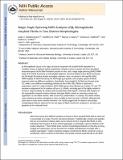Magic Angle Spinning NMR Analysis of β[subscript 2]-Microglobulin Amyloid Fibrils in Two Distinct Morphologies
Author(s)
Debelouchina, Galia Tzvetanova; Platt, Geoffrey W.; Bayro, Marvin J.; Radford, Sheena E.; Griffin, Robert Guy
DownloadGriffin_Magic Angle.pdf (1.298Mb)
PUBLISHER_POLICY
Publisher Policy
Article is made available in accordance with the publisher's policy and may be subject to US copyright law. Please refer to the publisher's site for terms of use.
Terms of use
Metadata
Show full item recordAbstract
β[subscript 2]-Microglobulin (β[subscript 2]m) is the major structural component of amyloid fibrils deposited in a condition known as dialysis-related amyloidosis. Despite numerous studies that have elucidated important aspects of the fibril formation process in vitro, and a magic angle spinning (MAS) NMR study of the fibrils formed by a small peptide fragment, structural details of β[subscript 2]m fibrils formed by the full-length 99-residue protein are largely unknown. Here, we present a site-specific MAS NMR analysis of fibrils formed by the full-length β[subscript 2]m protein and compare spectra of fibrils prepared under two different conditions. Specifically, long straight (LS) fibrils are formed at pH 2.5, while a very different morphology denoted as worm-like (WL) fibrils is observed in preparations at pH 3.6. High-resolution MAS NMR spectra have allowed us to obtain [superscript 13]C and [superscript 15]N resonance assignments for 64 residues of β[subscript 2]m in LS fibrils, including part of the highly mobile N-terminus. Approximately 25 residues did not yield observable signals. Chemical shift analysis of the sequentially assigned residues indicates that these fibrils contain an extensive β-sheet core organized in a non-native manner, with a trans-P32 conformation. In contrast, WL fibrils exhibit more extensive dynamics and appear to have a smaller β-sheet core than LS fibrils, although both cores seem to share some common elements. Our results suggest that the distinct macroscopic morphological features observed for the two types of fibrils result from variations in structure and dynamics at the molecular level.
Date issued
2010-07Department
Massachusetts Institute of Technology. Department of Chemistry; Francis Bitter Magnet Laboratory (Massachusetts Institute of Technology)Journal
Journal of the American Chemical Society
Publisher
American Chemical Society (ACS)
Citation
Debelouchina, Galia T. et al. “Magic Angle Spinning NMR Analysis of β[subscript 2]-Microglobulin Amyloid Fibrils in Two Distinct Morphologies.” Journal of the American Chemical Society 132.30 (2010): 10414–10423.
Version: Author's final manuscript
ISSN
0002-7863
1520-5126